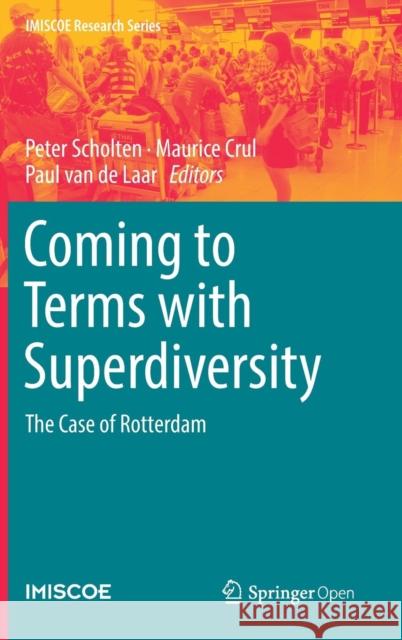Coming to Terms with Superdiversity: The Case of Rotterdam » książka



Coming to Terms with Superdiversity: The Case of Rotterdam
ISBN-13: 9783319960401 / Angielski / Twarda / 2018 / 241 str.
Coming to Terms with Superdiversity: The Case of Rotterdam
ISBN-13: 9783319960401 / Angielski / Twarda / 2018 / 241 str.
(netto: 192,11 VAT: 5%)
Najniższa cena z 30 dni: 192,74
ok. 22 dni roboczych.
Darmowa dostawa!
This open access book discusses Rotterdam as clear example of a superdiverse city that is only reluctantly coming to terms with this new reality.
1 Introduction – Peter Scholten, Maurice Crul and Paul van de Laar.- PART I: SUPERDIVERSITY IN ROTTERDAM: 2 Rotterdam’s superdiversity from a historical perspective (1600-1980) – Paul van de Laar and Arie van der Schoor.- 3 The second and third generation in Rotterdam: increasing diversity within diversity - Maurice Crul, Frans Lelie and Elif Keskiner.- 4 Between choice and stigma: Identifications of economically successful migrants - Marianne van Bochove and Jack Burgers.- PART II: ROTTERDAM’S RESPONSE TO SUPERDIVERSITY: 6 ‘Walking the walk’ rather than ‘talking the talk’ of superdiversity: Continuity and change in the development of Rotterdam’s immigrant integration policies - Rianne Dekker & Ilona van Breugel.- 7 Laboratory Rotterdam. Logics of exceptionalism in the governing of urban populations - Friso van Houdt & Willem Schinkel.- 8 Rotterdam as a case of complexity reduction: Migration from Central and Eastern European countries - Erik Snel, Mark van Ostaijen & Margrietha ‘t Hart..- PART III: ROTTERDAM IN COMPARATIVE PERSPECTIVE: 9.A tale of two cities: Rotterdam, Amsterdam and their immigrants - Han Entzinger.- 10. The ‘integration’ of people of Dutch descent in superdiverse neighbourhoods - Maurice Crul and Frans Lelie.- 11. Superdiversity and city branding: Rotterdam in perspective – Warda Belabas and Jasper Eshuis.- 12. Conclusions: Coming to terms with superdiversity? – Maurice Crul, Peter Scholten and Paul van de Laar.- 13. Epilogue: What’s the matter with Rotterdam? – Steve Vertovec.
Peter Scholten is associate professor Public Policy & Politics at Erasmus University Rotterdam. He is coordinator of the interdepartmental research cluster on the Governance of Migration and Integration. His research focuses on issues of intercultural governance, multi-level governance and knowledge & public policy. Also, he is co-editor in chief of the journal Comparative Migration Studies. Peter also partners in various research projects, including AMICALL and IMPACIM (COMPAS Oxford), PROSINT (ICMPD) and FP7 project UniteEurope. In addition, Peter is fellow of the Montesquieu Institute and member of the board of the Center for History of Migrants and associate researcher at the Center for Migration Policy and Society (COMPAS), at Oxford University. Peter is also coordinator of the IMISCOE research cluster on ‘Research-policy dialogues on migration and integration in Europe, member of the Immigration Research Group of the Council for European Studies (CES) and senior-member of the Netherlands Institute for Government (NIG).
Paul van de Laar was trained as economic historian and got his PhD form the Tinbergen Institute, School of Economics Erasmus University (1991). He continued his professional career in the interdisciplinary field of urban history and museum studies. His latest research is on comparative port history, migration and transnational developments in relation to urban transformations. Besides his academic research and teaching he is as managing director of Museum Rotterdam (the City Museum) responsible for the new focus on city museums and their role in a changing urban context, in particular superdiversity.
This open access book discusses Rotterdam as clear example of a superdiverse city that is only reluctantly coming to terms with this new reality. Rotterdam, as is true for many post-industrial cities, has seen a considerable backlash against migration and diversity: the populist party Leefbaar Rotterdam of the late Pim Fortuyn is already for many years the largest party in the city. At the same time Rotterdam has become a majority minority city where the people of Dutch descent have become a numerical minority themselves. The book explores how Rotterdam is coming to terms with superdiversity, by an analysis of its migration history of the city, the composition of the migrant population and the Dutch working class population, local politics and by a comparison with Amsterdam and other cities. As such it contributes to a better understanding not just of how and why super-diverse cities emerge but also how and why the reaction to a super-diverse reality can be so different.
By focusing on different aspects of superdiversity, coming from different angles and various disciplinary backgrounds, this book will be of interest to students and scholars in migration, policy sciences, urban studies and urban sociology, as well as policymakers and the broader public.
1997-2026 DolnySlask.com Agencja Internetowa
KrainaKsiazek.PL - Księgarnia Internetowa









